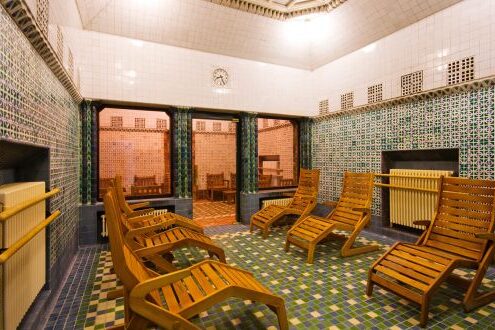Kaiser-Friedrich-Therme
The Kaiser-Friedrich-Bad, which opened in 1913 and is fed by the Adlerquelle spring, was modeled on ancient thermal baths. The original Art Nouveau décor can still be seen in various rooms today.
The Kaiser-Friedrich-Bad, today the Kaiser-Friedrich-Therme, was built between 1910 and 1913 as a municipal bathing and spa center according to the plans of the architect and city architect August O. Pauly (born 1874) on the site of the former bathhouse Zum Adler between Langgasse and Coulinstraße. The baths are fed by the Adler spring, which has been owned by the city since 1900 and is the second most important of Wiesbaden's thermal springs with a water temperature of around 64.6 degrees Celsius. At the entrance to the now smaller, originally 2000 square meter, landscaped forecourt stood a small temple in which the Adlerquelle spring bubbled to the surface.
In the service of health maintenance and treatment, it was intended that the architecture and artistic design of the Kaiser-Friedrich-Bad in the Art Nouveau style would have a positive influence on people's well-being through aesthetic interior design. The painter and interior designer Hans Völcker was responsible for the planning and partial execution of the interior design.
A total of nine reliefs adorn the northeast-facing main façade. The three of the central risalit were created by the sculptors Ernest (1879 - 1916) and William Ohly (1883 - 1955), the six of the three lateral axes by the sculptor Wilhelm von Heider (born 1882).
The entrance to the building leads into the former cashier's room, now the vestibule, which is artistically decorated with ceramics from the Royal Majolica Workshop in Cadinen in East Prussia (now Kadyny, Poland). The vestibule on the first floor is generously proportioned. A frieze by Völcker adorns the upper third of the four walls clad in light-colored marble. The leitmotif of the figure compositions is "the joy of the naked body and the emergence of strength, beauty and joie de vivre" (Meyer-Elbing).
The first floor originally housed inhalation facilities, thermal salon baths, a mud bath facility and a sand bath as well as the Roman-Irish department with the Russian steam bath. There were also baths for the severely disabled and seriously ill. In addition to the men's section, the second floor also housed the so-called Fürstenbad, while the second floor was home to the women's section.
The rooms and bathing facilities of the Roman-Irish section are located on both sides of the indoor swimming pool with a cold water pool measuring approx. six by twelve meters and a thermal bubble bath, the so-called wild pool. Above the approximately five-metre-high glazed wall cladding, caryatid-like male and female figures painted on narrow window pillars appear to support the ceiling cornice. These figures and the fresco on the inner front of the hall were created by the Wiesbaden painter Ernst Wolff-Malm.
The complex is modeled on ancient thermal baths. Two of the original hot-air rooms, the tepidarium (40 - 45 degrees C) and the sudatorium (50 - 55 degrees C), are lined with colored glazed tiles from the workshop of Henry van de Velde's pupil Josef Vinecký and have been preserved in their original form. The rooms are heated with large radiators and, following the example of Roman thermal baths, with hypocausts, heating chambers built under the tiled floor into which steam is introduced. The steam baths are based on Russian models and have been extended.
After a clinic moved into the building in 1962 and the spa was greatly reduced in size as a result, it was renovated and extended again in 1998/1999 at a cost of around four million euros. Today, the Kaiser-Friedrich-Therme offers a spacious bathing and sauna area on 1450 square meters on the ground floor and basement, which includes a sanarium (55 - 60 degrees C), a Finnish sauna and a stone steam bath in addition to the hot air rooms and the Russian steam bath. There are also rooms for cooling down and relaxing, a lavacrum with a cold-water plunge pool, a frigidarium, i.e. a fresh air room, and a tropical ice rain facility. Various treatments such as massages, sand baths, oriental rasul, soft packs and cosmetic treatments complete the offer.
The remaining rooms of the former Kaiser-Friedrich-Bad now house apartments, surgeries and the Peseschkian Foundation.
Literature
- Friedländer, Richard
The municipal Kaiser Friedrich Bad in Wiesbaden. In: Medical commemorative publication for the opening of the municipal Kaiser Friedrich Bad in Wiesbaden. Magistrat der Residenzstadt Wiesbaden (ed.), Wiesbaden 1913 (pp. 1-55).
- Meyer-Elbing, Oscar
The municipal bathhouse and inhalatorium Kaiser-Friedrich-Bad in Wiesbaden, offprint from the Leipziger Illustrirte Zeitung, 1913.
- Vollmer, Eva-Christina
The Kaiser-Friedrich-Therme in Wiesbaden, Lindenberg 2003.


